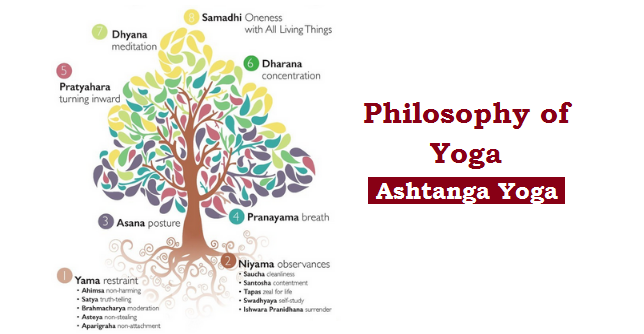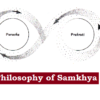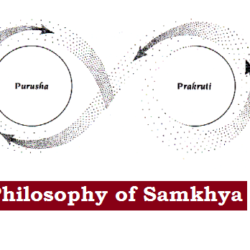
The word ‘Yoga’ literally means ‘union’, i.e., spiritual union of the individual soul with the universal soul and is used in this sense in the Vedanta. According to Patanjali, who is the traditional founder of the Yoga system, Yoga does not mean union but spiritual effort to attain perfection through the control of the body, senses and mind; and through right discrimination between Purusa and Prakriti. The ultimate goal of this philosophy is the absolute independence and eternal and free life of Purusa, free from Prakriti.
Yoga is the practical path of realization of the theoretical ideals of Samkhya Philosophy and presents a practical path for the realization of the self. Yoga admits all the three Pramanas accepted by Samkhya, i.e, perception, inference and scripture.
Yoga includes moral restraints, and spiritual imperatives, as well as the exercises (Asanas) designed to withdraw consciousness from the senses, focus the mind and ultimately achieve meditation in which the self is completely and transparently understood.
Chitta: Psychology of Yoga
Patanjali’s Yoga Sutra defines yoga as
‘योगश्चित वृत्ति निरोध:’
Meaning: Yoga is the cessation of the modifications of Chitta
Chitta essentially means the three internal organs of Sankhya- Buddhi (intellect), Ahankara (ego) and Manas (mind). Chitta is the first evolute (modification) of Prakriti and has the predominance of Sattva over Rajas and Tamas Gunas. It is in itself unconscious, but being finest and nearest to Purusa, it has the power to reflect the Purusa and therefore appears conscious.

Vritti:
When Chitta gets related to any object, it assumes the form of that object. This form is called Vritti (modification). Due to this modification, Purusha knows the worldly objects and Chitta, therefore, is the physical medium for the manifestation of Purusha (spirit).
Chitta Bhumi:
Chitta may remain in five different stages or levels known as ‘Chitta Bhumi’. The different levels of Chitta are determined by the different degrees in which the elements (Gunas) are present in it. In each of these stages, there is some kind of repression of mental modifications.
Ashtanga Yoga
Yoga advocates control over the body, the senses and the mind with the modifications of Chitta. Sensual attachment and passions distract body as well as the mind. They must be conquered.
To overcome them, Yoga gives us the Eightfold Path of Discipline or the Ashtanga Yoga:
- Yama (Self-restrained): abstention from i) Non-violence (Ahimsa) ii) Truth (Satya) iii) Non-stealing (Asteya) iv) Celibacy (Brahmacharya) v) Non-possession (Aparigraha). All the five above mentioned Yamas are necessary for the concentration of Chitta.
- Niyama (Good conduct): following rules of good conduct i) Purity (Saucha) ii) Contentment (Santosa) iii) Right aspiration (Tapas) iv) Study of scriptures (Svadhyaya) v) Devotion to God (Iswara Pranidhyana)
- Asana (Posture): steady and comfortable bodily posture which helps to retain concentration of Chitta, body and mind. This is the discipline of the body.
- Pranayama (Breath control): control of breath and deals with regulation of inhalation, retention and exhalation of breath. It helps the Chitta to remain concentrated.
- Prathyahara (Control of senses): control of the senses and consists in withdrawing the senses from their objects. It is the process of introversion.
- Dharana (Focus): focusing he mind on the object of meditation like unflickering flame of a lamp.
- Dhyana (Meditation): concentrating the mind without any break. It helps to realize the true nature of Chitta. Dhyana culminates in Samadhi.
- Samadhi (Concentration): mind is completely absorbed in the object of meditation. In Dhyana, the act of meditation and object of meditation remain separate. But here they become one and identical. This stage is known as the cessation of modification of Chitta.

 Home
Home Syllabus
Syllabus Contact Us
Contact Us








